I’ve shared intimate details of my birth stories, revealed the dark side of blogging, and exposed the extent of my crunchiness writing about menstrual cups…
I haven’t written much about homeschooling, even though it is a big part of my family’s life, because I didn’t think it would interest most of you.
When a picture of our homeschool room became the most popular picture I’ve shared on Instagram, many of you asked details about specific parts of the picture, so I decided to write about our homeschool classroom.
Don’t Homeschool?
I hope that some of the tips in this post will be helpful to you, even if your kids are not taught at home.
I have two children who are technically under “school-age,” and many of the things I have in our school room are there to engage their creativity and keep them busy while the older kids learn. These activities would be helpful for children who aren’t of school age yet, but still want to be involved in the learning process.
My Homeschool Classroom Philosophy
One of the many reasons we decided to homeschool our children is that we felt we could give them a more detailed and diverse education than they could get in a typical school system.
In short, my philosophy is that learning happens 24/7 with children, and that while we might focus on specific topics during certain parts of the day, we teach them all the time.
We tie in aspects of the Montessori teaching method, along with a couple of traditional learning curriculums (this one and this one are the two we’re currently using) and many hands-on activities and field trips. While I love the Montessori philosophy, we spend a great deal of time outside in the treehouse, going for walks, and playing than sitting in the classroom whenever we can. We also try to allow the children to have some autonomy in choosing the specific activities that they do and the subjects they learn first each day.
We also incorporate travel into our learning whenever possible, as children learn much more from visiting a place or culture than they could from simply reading about it.
So while I love our little school room, I also really love the time we spend learning outside of it.
Setting Up Our Homeschool Classroom
As we prepare to begin school this year and I set up the classroom, I’m sharing my personal homeschool ideas, so I hope you’ll share yours in the comments so we can all learn from each other.
Our homeschool room reflects the diversity of learning methods we use and the diversity of ages we teach. My children are all currently under 10 years of age, so obviously, a much different environment would be needed for older children.
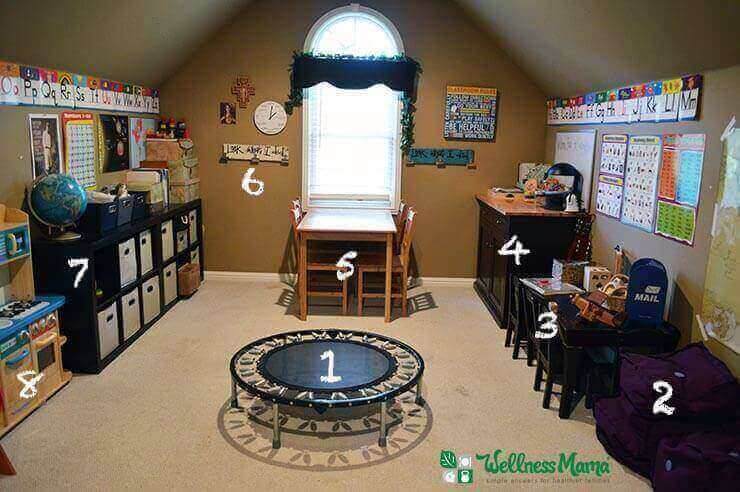
I followed the idea of “Workstations” that is popular in Montessori schools in setting up our classroom. My goal was to have different stations that my children could rotate to and each have their own space for independent learning.
These are the “Stations” we have and how we use them:
- Jumping station: I’ve found that especially for active boys, movement actually improves learning, rather than stifling it. In fact, sitting for too long in one place quickly makes them bored and inattentive, while being able to move helps them focus. I’ve used rebounding for health for years, and I love that kids can use it as an indoor exercise while learning (and this builds on the Montessori idea that movement enhances cognition). We mainly use the mini-trampoline (or rebounder) to let them jump while we read, teach a lesson, or while quizzing them on spelling, multiplication tables, etc. It is also a great place for them to move around during breaks, especially when it is raining outside.
- Reading Station: Pictured above in the top image in this post, the reading station is a little area with three beanbags for sitting on to read. This is used for independent reading or studying and is a good break from sitting in chairs.
- The Little Kids Station: The favorite spot of the under 5 crowd, this mini-table is a refurbished old coffee table that lost a leg and that we rescued and refurbished. The top has a ledge so small pieces won’t fall off, and the surface is covered in chalkboard contact paper so that they can practice writing on the table itself. This is one of two stations specifically for the little kids and the chairs are mini-sized as well. See more detail below for the specific activities we have at this table.
- School Cabinet and Teacher Station: We found that having the school books in an open space where the kids could access them at all times led to little kids trying to learn like the big kids by becoming interested in books. Our solution was an old cabinet (technically a kitchen island) that we found at a salvage store. We installed child locks on the doors and now each child has a cubby inside the cabinet for books. We open it during school and return the books after school time. This also minimizes the mess. The top of the station is home to teacher supplies, our school plant and some flash cards. See more detail below.
- The Workbook Station: The older children take turns working at this table with one of us at a time, and while we try not to sit for very long, a table is a great place for the necessary book work or test.
- Artwork Display: A friend made these adorable artwork display boards and they help keep a handle on the amount of precious artwork on the walls at any given time. Each child has one “clip” and can display a piece of artwork or something they’ve worked on in school that week. It is just a board with some heavy metal clips that say “Look What I Did..”
- Learning Station Storage: I list some of our specific learning stations below, but these bins contain sets of flash cards, beading activities for little ones, lacing cards, art supplies, and Montessori learning stations. We also keep the few toys that we have in these bins (legos, blocks, etc).
- Little Kid Play Station: A play area for the little ones. A kitchen set with wooden toys, an art easel for painting, drawing with chalk, whiteboard writing and other activities. More below.
- Acrobatic Station: (Not Pictured) Hanging in the door of our school room is a Gorilla Gym (the best Christmas present we’ve ever gotten for our kids). This indoor playground is essentially a super strong pull-up bar with five attachments for play and exercise. The pull up bar is strong enough for adults to use, but a swing, a climbing rope, rings, a trapeze and a ladder can be added for the children to play. This is a great station for them to get their energy out or swing while listening to a lesson or a language CD.
- Book Station: (not pictured)- A simple bookcase of books that the children can access any time.
More detail on the various stations….
The Little Kid Learning Stations
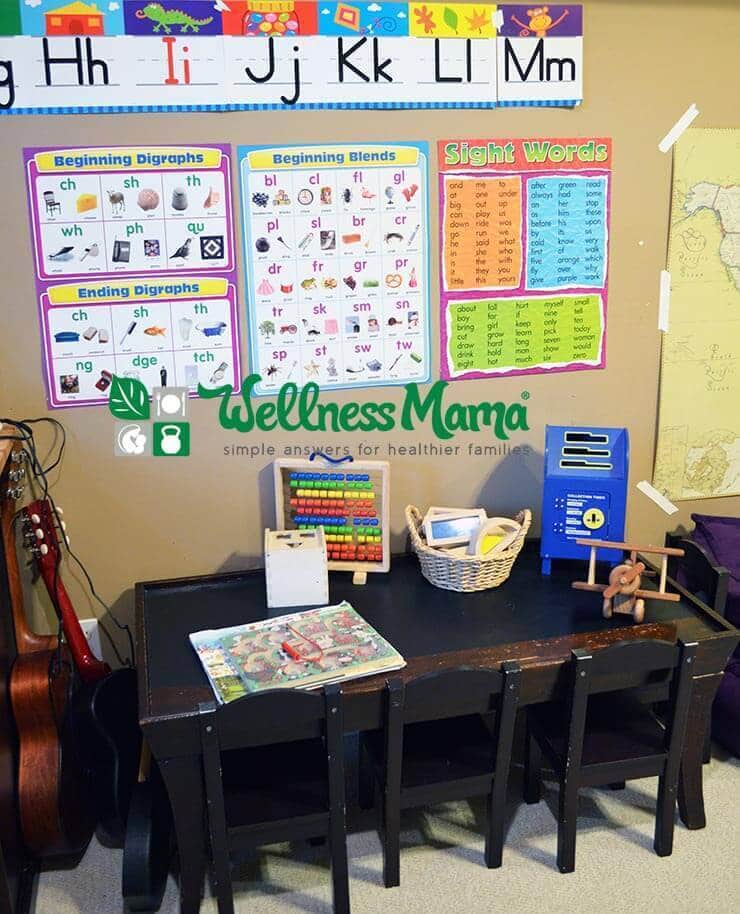
Many of our little kid activities are stored in the bins on the other side of the classroom and not pictured, but some of their favorite activities are:
- Sorting Beads: I have a few dozen wooden beads that I’ve painted in various colors. The little ones can sort these into little wooden bowls that are painted the same color.
- Threading Beads: I use more of these painted wooden beads in a station where little ones can thread beads. They use shoelaces to thread the beads in various patterns.
- Sandpaper Letters: They have lowercase letters and uppercase letters on cards made out of sandpaper. This gives them a tactile experience of learning the letters and they really enjoy it. I know many moms who make these letters out of index cards and sandpaper, but this is one activity I chose to buy to save time getting ready for school.
- Lacing Cards: Another favorite activity for little ones… you could absolutely make these out of cardboard and shoelaces, but our kids got this set as a gift and it has been great for school.
- Counting Stations: For learning numbers, we have several activities: A magnetic learning maze (great for motor skills and counting), A count and sort, the abacus, and number rods.
- Blocks: They enjoy these blocks filled with colored sand to add another sensory element.
- Shapes and Fractions: We have cards and drawing modules for this, but also this Fraction Action Board, which we also use to teach the older ones fractions.
- Puzzle Stations: We have a box full of age-appropriate puzzles for little ones. They especially like this skeleton floor puzzle for learning the bones of the body.
- Arts and Crafts: When I’m feeling especially brave/crazy, we have painting, coloring, modeling clay and cutting stations for them to use. These are typically a special treat since they require more cleanup, but we try to do these a couple times a week.
- Wooden Animals: I got a big set of these non-toxic wooden Animals toys as a baby gift and they are one of the most played with activities for kids. They draw pictures of scenery to play with the animals on, make baby clothes to dress them up in, and match them to their zoo animal cards. These are also great to put in the diaper bag for church and other quiet times.
- Reading Station: Another favorite is a bin of board books and sensory books specifically for little ones. They like having their own books and “reading” them. They also have their personal books that I make for them each year with pictures and memories from the last year and they love looking back over these memories and asking about them.
- Music Station: Various wooden musical instruments for music time. We also have opera and classical music CDs for learning about music throughout history. Opera is the little kid favorite at our house.
We try to encourage the kids to only use one station at a time and clean it up before moving on to another. I’m not a Montessori perfectionist, and at times, several stations will end up out at one time, but in general, the idea of stations cuts down on mess. The rest of the little kid station includes a kitchen set with wooden food (another Christmas gift) and an art easel (also a Christmas gift)…
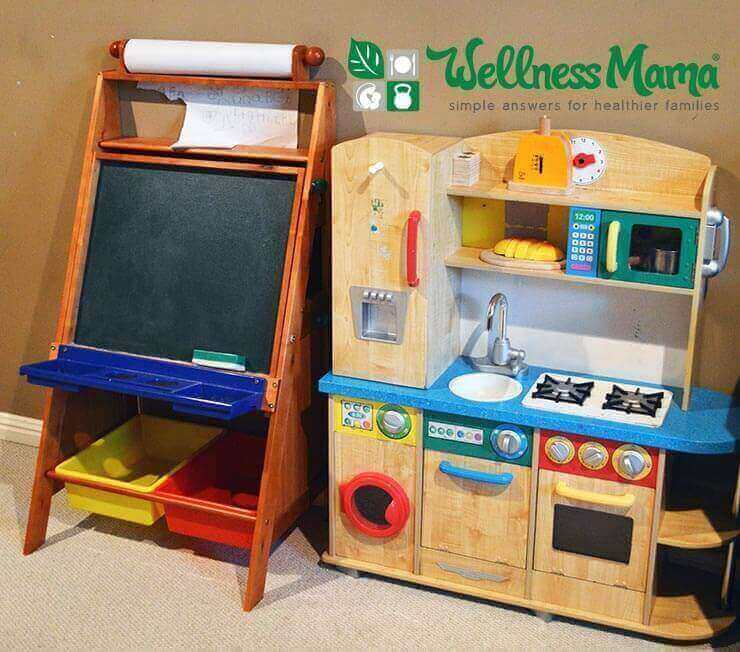
Big Kid Learning Stations
As I mentioned, we try to facilitate as much learning as possible outside, while traveling or while moving, but we do follow a hands-on curriculum for the older kids. I’ve set up learning stations for them as well, and they rotate so that we can teach them all easily.
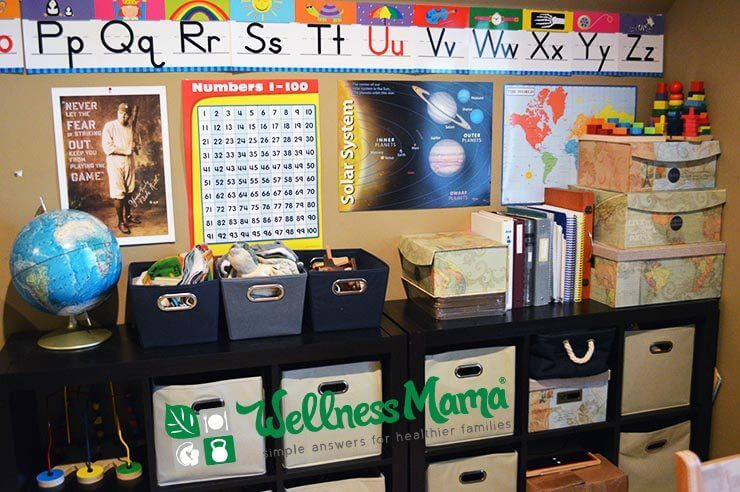
The stations for the older kids include:
- School books: Kept in out school cabinet, these school books and workbooks are the core of the curriculum we use.
- Geography Station: The globe and big maps are used when teaching about geography and we also have puzzles, colorable maps, and matching games for this.
- Language Stations: This year, we are teaching the children Italian since it is part of their heritage. We have Little Pim Language Set for the littles and Rosetta Stone for the older ones. My husband teaches this subject since he speaks some Italian.
- Phonics and Reading Stations: I take an unusual approach to language and phonics. While teaching the basics of phonics and reading, I also use flash cards that I’ve made of the 100 most used words in the English language and flash cards of English From the Roots Up- Greek and Latin Roots (which I learned in school myself and which I credit partially with my high score on the SAT). The greek and latin roots help them understand language as they learn more complex words and make it easier to figure out what longer words mean.
- Lego Boxes and Hundreds Boards: Basic lego blocks are great for teaching counting, fractions, stacking and other number related activities. We also will incorporate these into subjects like history (letting them build models of ancient buildings) or science.
- Horticulture Station: We haven’t planted our plants for the year yet, but we have indoor plants, herbs and greens that the children tend during school each day. We also do experiments with sprouting seeds and planting for the garden to help them learn about this.
- Art Stations: Natural paints, coloring, clays, glue and scissors that we use for various activities.
- Science Experiments: We have various hands on experiments and stations for learning chemistry, biology, physics, etc. and the materials for these are stored in the boxes as well. Some favorites are the anatomy models we use for teaching biology, and the physics experiments.
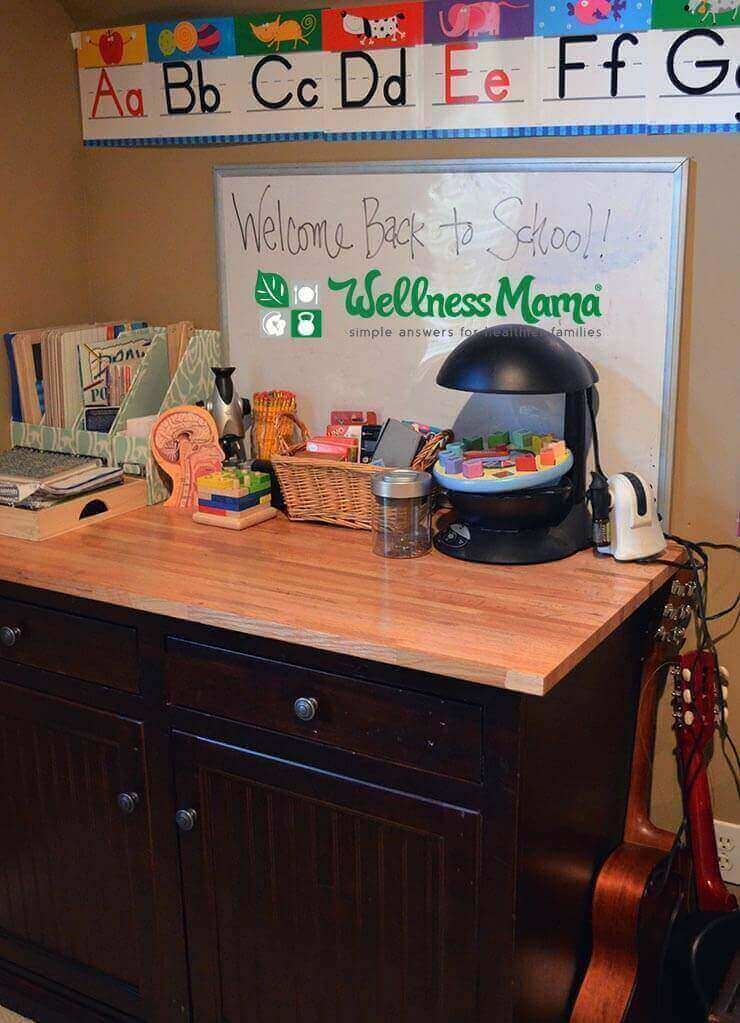
Homeschool Classroom Decoration
The decorations in our classroom are very simple. I have some homeschooling friends whose classrooms are awe-inspiring, but I didn’t have the time/energy to create everything from scratch and opted for some basics from the local teacher supply store.
We have a simple alphabet poster around the top of the room and various learning posters that I change out throughout the year.
Once we begin school, most decorations are artwork or school work the kids have completed and it changes constantly.
Real Life Learning:
As important as structured learning is, my favorite thing to teach (and probably their favorite thing to learn) is what I call “Real Life Learning,” or lessons that help provide real life skills.
This may be anything from coming to the store and farmers market with me and helping determine which foods are the best deal (per ounce), making tinctures or salves with me, going on a nature hike and learning about wildcrafting or some form of fitness.
I try to involve my kids in activities like cooking dinner, doing laundry, sewing on buttons, and even balancing the checkbook (for the older ones) as these are practical skills that they will absolutely need one day, no matter what career or further education they choose.
In fact, most of the recipes on this blog are ones that my children helped me with in some way.
Important Note
I’m sharing our school room for informational purposes. I’m not an expert by any means and am learning as I go. Also, lest anyone think that our home and school room always looks this neat, the school room is organized right now because we haven’t begun our year school yet. 🙂
While we aim to keep things this clean and organized, it doesn’t always happen during school. I also attempt to be patient every single day during school and that doesn’t usually happen either. 🙂
The system, stations and notes above are optimal for our school system, but by no means do all aspects of this happen perfectly every day. Like parenthood, homeschooling is a moving target that seems to be constantly adapting and changing. There is no one-size-fits-all approach. Keep experimenting until you find the best homeschool schedule and set-up for you!
I hope that some of my tips will be helpful to you, and I’d love to hear some of your top tips for homeschooling or teaching your children as well.
Do you homeschool? What does your homeschool classroom look like? Have you found any tips, tricks, or hacks that make the learning process easier?

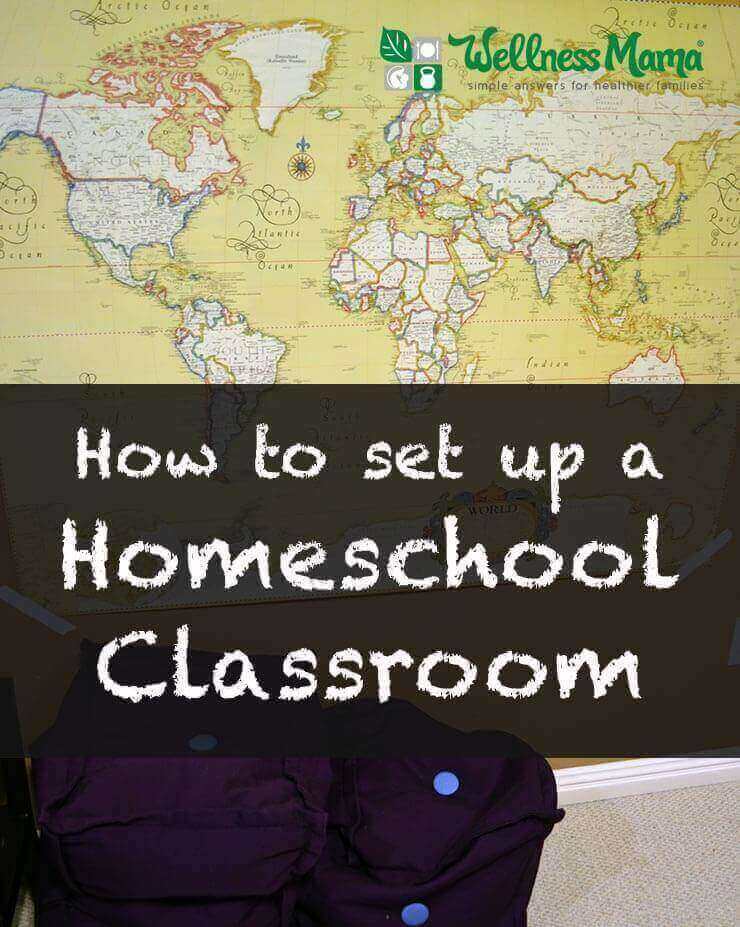
Leave a Reply